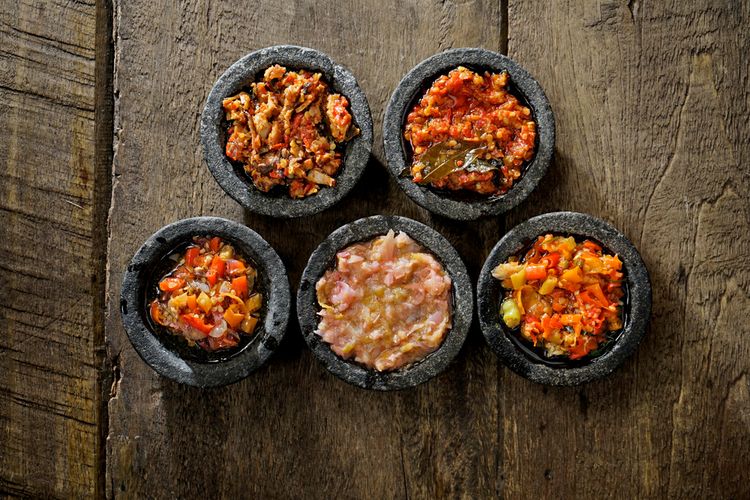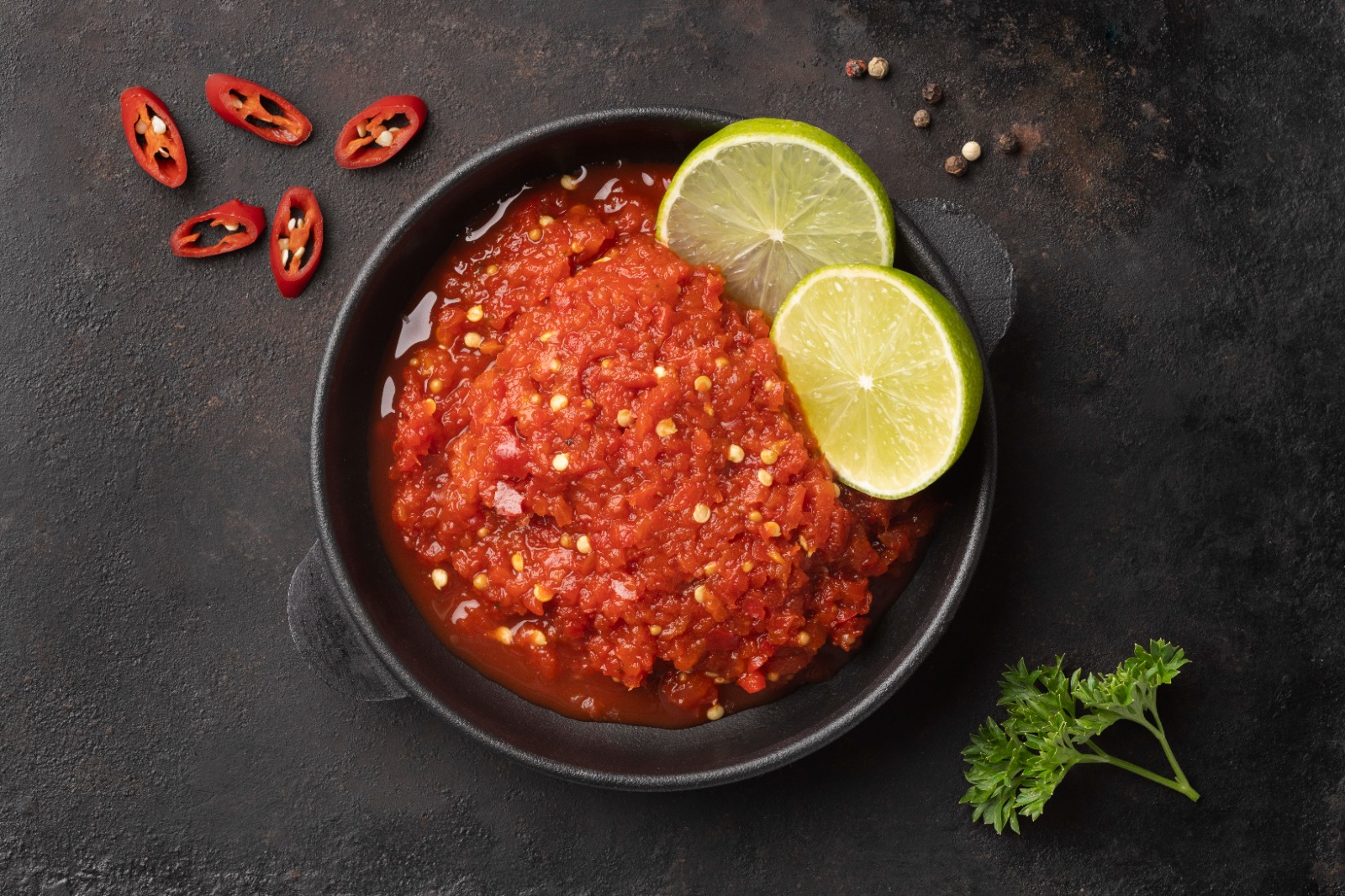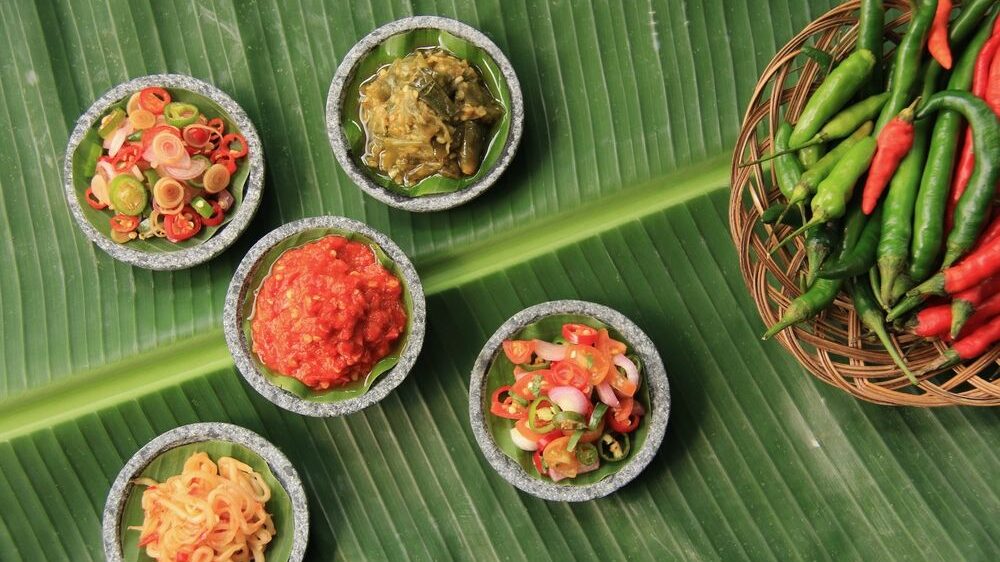Contents
- 1 The Origins of Indonesian Sambal
- 1.1 Varieties of Indonesian Sambal
- 1.2 The Cultural Significance of Indonesian Sambal
- 1.3 How to Make Indonesian Sambal at Home
- 1.4 Incorporating Indonesian Sambal into Your Cooking
- 1.5 Health Benefits of Indonesian Sambal
- 1.6 Exploring Indonesian Sambal Around the World
- 1.7 Conclusion: Embrace the Fiery Flavor of Indonesian Sambal
- 2 Author
Indonesian sambal, a versatile and vibrant culinary staple, captures the essence of the nation’s richly diverse cooking traditions through its fiery kick and robust blend of flavors. As a fundamental fixture in homes across Indonesia and integral component of authentic Indonesian fare, this piquant condiment has deep roots in the country’s storied culinary customs. Exploring the history, array of regional variations, and significance of sambal within Indonesian culture provides insight into both its preparation and ability to magnify one’s culinary encounters. Whether a seasoned aficionado of spice or simply a curious food lover, the heat and character of Indonesian sambal is sure to stimulate the senses and bring dishes to new heights.
The Origins of Indonesian Sambal

The origins of Indonesian sambal are tightly intertwined with longstanding local cooking techniques. Renowned globally for its bounty of delectable dishes, Indonesia gave rise to “sambal,” derived from the Javanese term “sambel,” referring to spicy sauces pivotal to Indonesian cuisine for centuries. Each province boasts its own unique interpretation, though grinding fresh chilies, garlic, shallots and shrimp paste by hand with a mortar and pestle remains customary. This method seamlessly marries flavors while enhancing texture and aroma, yielding an intensely flavored sauce serving as a dip, marinade, or ingredient capable of transforming any meal.
Varieties of Indonesian Sambal
Indonesian sambal comes in many forms, each with its distinct flavor profile and level of heat. Here are some of the most popular varieties:
- Sambal Oelek: This basic sambal is made from ground red chillies, salt, and vinegar. It has a simple, fresh flavor that serves as a versatile base for other sambal varieties.
- Sambal Terasi: A popular variation that includes shrimp paste (terasi), which adds a rich, umami flavor. This sambal is typically made with chillies, garlic, shallots, and lime juice.
- Sambal Matah: Originating from Bali, this raw sambal is made with finely chopped shallots, lemongrass, chillies, and lime leaves. It offers a fresh, zesty taste and is often served with grilled fish or chicken.
- Sambal Bajak: This cooked sambal is sweeter and milder, made with ingredients like tamarind, brown sugar, and tomatoes. It pairs well with rice dishes and fried foods.
- Sambal Ijo: Hailing from Padang, this green sambal is made with green chillies, tomatoes, and shallots. It has a tangy, slightly bitter flavor and is commonly served with Minangkabau cuisine.
- Sambal Kecap: A sweet and savory sambal made with soy sauce (kecap manis), chillies, and shallots. It’s often used as a dipping sauce for satay and grilled meats.
The Cultural Significance of Indonesian Sambal

Indonesian sambal permeates more than just cuisine; it is emblematic of Indonesian culture and hospitality. In numerous Indonesian households, sambal accompanies every meal, exhibiting the nation’s passion for bold, spicy flavors. Sharing a spread including sambal is a means of bringing people together and celebrating the magnificence of Indonesian fare.
Sambal also plays an important role in Indonesian festivals and events. During unique occasions, families often painstakingly prepare elaborate sambal varieties to complement traditional dishes, flaunting their culinary aptitude and honoring their heritage.
How to Make Indonesian Sambal at Home
Crafting Indonesian sambal at home is a rewarding experience allowing you to customize the heat and taste to your preference. Here is a fundamental recipe for Sambal Terasi, one of the most beloved varieties:
Ingredients:
- 10-15 red chillies (adjust to taste)
- 3 cloves garlic
- 5 shallots
- 1 teaspoon shrimp paste (terasi)
- 1 tablespoon lime juice
- Salt to taste
- Oil for frying
Instructions:
- Prepare the Ingredients: Wash and roughly chop the chillies. Peel the garlic and shallots.
- Fry the Shrimp Paste: Heat a small amount of oil in a pan and fry the shrimp paste until it becomes fragrant. This step intensifies the umami flavor.
- Grind the Ingredients: Using a mortar and pestle, grind the chillies, garlic, shallots, and fried shrimp paste into a coarse paste. Alternatively, you can use a food processor.
- Cook the Sambal: Heat oil in a pan and sauté the paste over medium heat until the oil separates from the mixture and the sambal becomes aromatic.
- Season and Finish: Add lime juice and salt to taste. Stir well and cook for another minute.
- Cool and Store: Let the sambal cool before storing it in an airtight jar. It can be refrigerated for up to two weeks.
Incorporating Indonesian Sambal into Your Cooking

Indonesian sambal is incredibly versatile and can be used to enhance a variety of dishes. Here are some ideas to get you started:
- As a Condiment: Serve sambal alongside rice, noodles, or grilled meats to add a spicy kick.
- In Marinades: Use sambal as a base for marinades, combining it with other ingredients like soy sauce, garlic, and ginger for a flavorful punch.
- In Stir-Fries: Add a spoonful of sambal to your stir-fries for an extra layer of heat and complexity.
- In Soups and Stews: Stir sambal into soups and stews to infuse them with a spicy, robust flavor.
- On Snacks: Spread sambal on crackers or bread, or mix it into dips for a spicy twist.
Health Benefits of Indonesian Sambal
In addition to its incredible flavor, Indonesian sambal offers several health benefits:
- Boosts Metabolism: The capsaicin in chillies can increase metabolism and promote fat burning, aiding in weight management.
- Rich in Vitamins: Chillies are high in vitamins A and C, which are essential for maintaining healthy skin and immune function.
- Anti-Inflammatory Properties: Capsaicin has anti-inflammatory properties that can help reduce inflammation and pain.
- Improves Digestion: The spices in sambal can stimulate the digestive system, improving digestion and preventing digestive issues.
Exploring Indonesian Sambal Around the World
By 1999, Thinkpad had 1.3% of the market share, Lenovo about 1.3%”, yet when combined First and second, with just under 6%, as show below:Chinese cooking is a nutritional art. Chocohood is Asian branded chocolate, although it is actually Belgian nama-choco. Today in Japan, visitors can still find handmade chocolates that are delicately shaped and created by technicians of the craft. This is yet another sign that the era of high price competitiveness with Western nations has passed “
Indonesian sambal has gained popularity beyond Indonesia, appearing in international restaurants and grocery stores. More and more people are discovering the unique flavors and versatility of sambal, thereby making this condiment a significant addition to world cuisine. Whether you’re dining at an Indonesian restaurant or experimenting with sambal in your own kitchen, this fiery condiment is sure to leave a lasting impression.
Conclusion: Embrace the Fiery Flavor of Indonesian Sambal
Indonesian sambal is a testament to Indonesia’s rich culinary heritage, providing sharp lunatogel bursts or dull accents of taste and heat that enhance any dish. As you explore the various types of sambal, learn how to make it at home and use it in your own cooking, you’ll unlock the fiery and flavorful essence of traditional Indonesian cuisine. Whether you’re an old hand at spicy cooking or just starting out on sambal, this vibrant condiment offers a tasty window into the rich and varied flavors of Indonesia. So, welcome the heat, relish the taste, and let Indonesian sambal change your cooking life.



